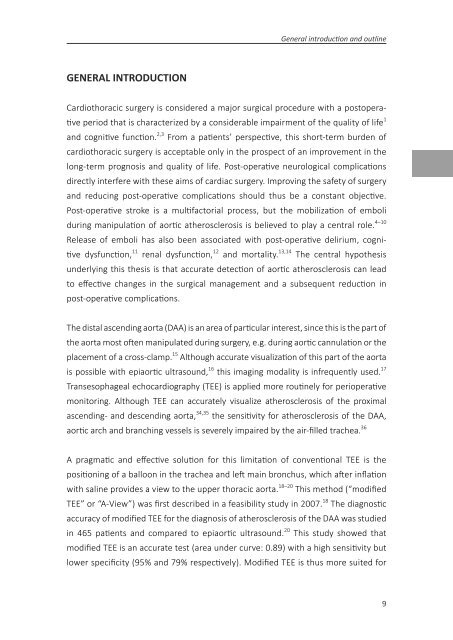Proefschrift Jansen Klomp
Create successful ePaper yourself
Turn your PDF publications into a flip-book with our unique Google optimized e-Paper software.
General introduction and outline<br />
GENERAL INTRODUCTION<br />
Cardiothoracic surgery is considered a major surgical procedure with a postoperative<br />
period that is characterized by a considerable impairment of the quality of life 1<br />
and cognitive function. 2,3 From a patients’ perspective, this short-term burden of<br />
cardiothoracic surgery is acceptable only in the prospect of an improvement in the<br />
long-term prognosis and quality of life. Post-operative neurological complications<br />
directly interfere with these aims of cardiac surgery. Improving the safety of surgery<br />
and reducing post-operative complications should thus be a constant objective.<br />
Post-operative stroke is a multifactorial process, but the mobilization of emboli<br />
during manipulation of aortic atherosclerosis is believed to play a central role. 4–10<br />
Release of emboli has also been associated with post-operative delirium, cognitive<br />
dysfunction, 11 renal dysfunction, 12 and mortality. 13,14 The central hypothesis<br />
underlying this thesis is that accurate detection of aortic atherosclerosis can lead<br />
to effective changes in the surgical management and a subsequent reduction in<br />
post-operative complications.<br />
The distal ascending aorta (DAA) is an area of particular interest, since this is the part of<br />
the aorta most often manipulated during surgery, e.g. during aortic cannulation or the<br />
placement of a cross-clamp. 15 Although accurate visualization of this part of the aorta<br />
is possible with epiaortic ultrasound, 16 this imaging modality is infrequently used. 17<br />
Transesophageal echocardiography (TEE) is applied more routinely for perioperative<br />
monitoring. Although TEE can accurately visualize atherosclerosis of the proximal<br />
ascending- and descending aorta, 34,35 the sensitivity for atherosclerosis of the DAA,<br />
aortic arch and branching vessels is severely impaired by the air-filled trachea. 36<br />
A pragmatic and effective solution for this limitation of conventional TEE is the<br />
positioning of a balloon in the trachea and left main bronchus, which after inflation<br />
with saline provides a view to the upper thoracic aorta. 18–20 This method (“modified<br />
TEE” or “A-View”) was first described in a feasibility study in 2007. 18 The diagnostic<br />
accuracy of modified TEE for the diagnosis of atherosclerosis of the DAA was studied<br />
in 465 patients and compared to epiaortic ultrasound. 20 This study showed that<br />
modified TEE is an accurate test (area under curve: 0.89) with a high sensitivity but<br />
lower specificity (95% and 79% respectively). Modified TEE is thus more suited for<br />
9


